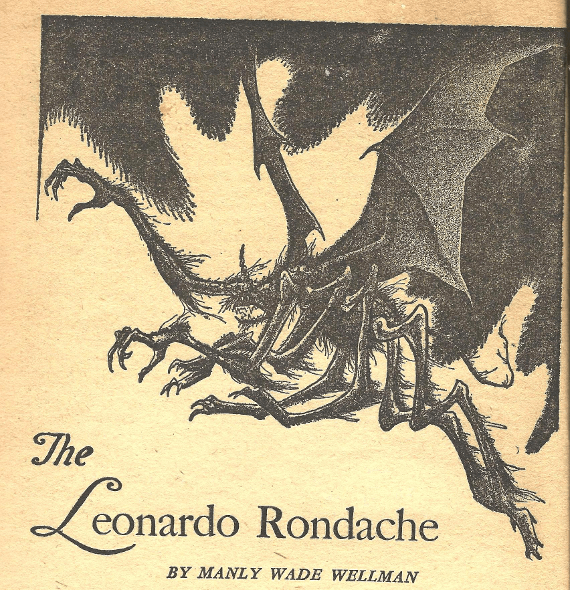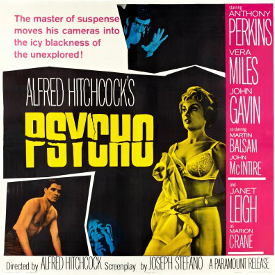
Prozine review: WEIRD TALES

Weird Tales – (March, 1948)
Editor: D. McIlwraith. Assistant Editor: Lamont Buchanan.
I was rummaging through one of my archive closets and came across something I had forgotten I had, namely the twenty-fifth anniversary edition of WEIRD TALES, published in March of 1948.
It is one of those magazines everyone interested in weird SF and horror has heard about, but I suspect few modern fen have ever seen. Certainly this is the only copy I have ever come across. Bought it at an old Vancouver store that used to specialize in rare genre works. I remember drooling over a display case filled with original letters by Lovecraft. Alas, I never had enough money to spare for the treasures spilling about the modest-sized store which, sad to say, has been gone for at least thirty years. Can’t even remember the name. Proprietor had a beard and a contempt for all “modern” fiction. Nothing but “good stuff” on display. Old stuff. Evocative stuff. Expensive stuff. Sigh.
The first thing to strike me, other than the Lovecraftian cover by Lee Brown Coye, is the statement in the colophon that “This magazine was produced in Canada, on Canadian Paper, by Canadians.” I had no idea the Canadian national inferiority complex was so strong back in the day. Then I noted it was issued by the American News Company, Limited, of 474 Wellington Street, Toronto, Ontario, by arrangement with Weird Tales, Inc. 9 Rockefeller Plaza, New York, New York.
Aha! Now I get it! Canada was still reeling from the economic effects of the war, during which importation of American magazines had been banned (something to do with currency control) and was evidently still banned in 1948. American zines got around this by licensing Canadian companies to publish American zines, though how any of the profit got back to the Americans I have no idea. Lots of work for accountants in those days.
The editorial in WEIRD TALES was titled “The Eyrie” and in this issue is given over to two of its prominent contributors.
August Derleth was a weird fiction writer and the owner of Arkham House publishing which was devoted to such, especially the works of Lovecraft. To digress, I just pulled out the Arkham House edition of THE DUNWHICH HORROR AND OTHERS from my shelf where I keep especially beloved books and discovered I had managed to get Robert Bloch to sign it when he was Guest of Honour at VCON 13 in 1985. Huzzah! I am not entirely bereft of neat and nifty stuff. Cool!
Digressing further, I note that the cover art of the Arkham House book was done by Lee Brown Coye, the same artist featured in this issue of WEIRD TALES. I wonder if he specialized in weird art? Probably not. A limited market. But he seems to have been popular in the genre.

Anyway, August Derleth wrote in the editorial:
“When I began to read WEIRD TALES with the very first issue, I was thirteen, and I had to work at mowing lawns, chopping wood, and the like to earn the quarter that would buy the magazine. Few purchases have ever given me such lasting satisfaction … the deep reading satisfaction I knew in such stories as Lovecraft’s The Rats in the Walls, Quinn’s The Phantom Farmhouse, Arnold’s The Night Wire, Smith’s A Rendevous in Averoigne, Whitehead’s Passing of a God, Burk’s The Ghosts of Steamboat Coulée, Howard’s The Black Stone, Moore’s Shambleau, Counselman’s The Three Marked Pennies, Dyalhis’ When the Green Star Waned, Wandrei’s The Red Brain, Munn’s The Werewolf of Ponkert, Bradbury’s The Lake, Suter’s Beyond the Door, Owen’s The Wind that Tramps the World, Long’s The Hounds of Tindalos, La Spina’s Invaders from the Dark, Price’s Stranger from Kurdistan, Jacobi’s Revelations in Black, Merritt’s The Woman in the Wood, Hamilton’s Monster God of Mamurth, Talman’s Two Black Bottles, Worrell’s The Canal, Leahy’s In Amundson’s Tent, Bloch’s Enoch, and countless other stories.”
I am familiar with maybe half the authors mentioned, but nearly all of the titles quoted make me wish I had a mint set of every issue of Weird Tales published up to the 25th anniversary. To heck with writing columns and fanzines, publishing a fiction zine and chairing conventions; I’d give it all up to sit in a comfy chair wearing comfy clothes and comfy slippers and a large pot of gunpowder tea beside me as I slowly savour the stories in each and every issue. Sounds like fun to me! Heck of a retirement plan. Then again, maybe not. Can’t afford it.
Seanbury Quinn, in his part of the editorial, refers to the readership as a “sophisticated minority … people fed up with the boy-meets-girl formula …” who flocked to WEIRD TALES because its writers had one thing in common, the ability “to tell good stories well.”
He goes on to say “It has been said that ‘WEIRD TALES prints slick-paper fiction wrapped in pulp.’ However false or true that estimate may be it is an undisputed fact that more WEIRD TALES writers are ‘tapped’ for inclusion in anthologies than those of any other pulp magazine, that many of its regular contributors are also ‘names’ in the slick paper field, and that a high percentage of them have had one or more successful books published.”
I have no idea if any of this is true but it certainly sounds promising. Eagerly I open the anniversary issue to peruse its contents. I assume I read it when I first got it, but have since forgotten everything. I will pass judgement on each story as if it were something new being submitted by modern Canadian authors to my SpecFic magazine Polar Borealis.
There’s a poem by Lovecraft, titled The House. Has an intriguing beginning:
“Tis a grove-circled dwelling
Set close to a hill
Where the branches are telling
Strange legends of ill;
Over timbers so old
That they breathe of the dead,
Crawl the vines, green and cold,
By strange nourishment fed;
And no man knows the juices they suck
From the depths of their dank slimy bed.”
Righto! Vaguely unsettling. Definitely creepy. Most of the remaining lines are lesser stuff, condemning this piece to minor status. Still, Lovecraft’s sense of humour is at play. But then it gets out of hand with the last six lines:
“But I shivered with cold,
Groping feebly for light,
As a picture unrolled—
And my age-spanning sight
Saw the time I had been there before
Flash like fulgary out of the night!”
Fulgary? FULGARY! Who in Nylarthotep’s name uses a word like that? I figure Lovecraft had an exceptionally smug smile on his face when he typed that one out. Bastard. Forced me to reach for my less than adequate dictionary.
Turns out it probably had something to do with “fulgurate – Emit vivid flashes like lightning.” So the poem means “Flash like flashes of lightning”? Isn’t that a bit redundant? I can see the famous Lovecraft circle of correspondents sitting around grinning inanely. He probably wrote the whole poem on a dare, just to provide an excuse for using “fulgary.” Darned annoying.
Would I turn down this poem were it to appear in my E-box? Absolutely. Partly because most of it is dull, but mainly because of “fulgary.” As an editor I’m against anything that pulls the reader out of a story or poem. In this case, the reader is catapulted out.

The first story, described as a novelette, is The Might-Have-Been by Edmond Hamilton. Always had a soft spot for Hamilton. His City at World’s End was the second SF pocket book I bought, I think when I was about ten years old. He was mostly noted for his Captain Future space opera series. So what was this story about?
A scientist named Graham has figured out there are an infinite number of alternate earths. Dissatisfied with the world of 1948, he has invented a device which will project his mind into three of his alternative selves in turn, then automatically and safely return his thought-self to his home laboratory. He has no influence on the body and mind of his other selves, but is present as a passive observer. What does he see?
Graham lives in the 1948 medieval city of New York and is sentenced to death for poaching in the American King’s forest.
Grahm is an astronomer in the Temple of the Sun at New Mayapan in 1948, and through a process of triangulation discovers the true distance of the stars just as the Aztecs burst through the city walls and slaughter the entire population.
Gra serves the Reptile Masters, descendants of the never-wiped-out dinosaurs, in the 1948 City of the Scaled Ones. He escapes with a few friends to sail north along the coast to where the land is too cold for the Reptile Masters to follow.
Home again, Graham decides his version of 1948 isn’t so bad after all. Yeah, I’d probably buy it for my Polar Borealis Magazine, though it’s a trifle pulpish. Have no idea what Lee Brown Coye’s illustration above has to do with it though. I guess they had to stick it in somewhere.

Boris Dolgov’s illo (above) for The Leonardo Rondache looks good. Story by Manly Wade Wellman, most famous for his John the Balladeer stories.
A Rondache is a kind of shield, and Prendic Norbier has discovered a famous Rondache painted by Leonardo da Vinci when he was a young boy, painted with an image of a rather horrible creature, of which Dolgov’s piece is a rather good approximation. What Norbier does not know is that Leonardo did the piece for a sorcerer. Nothing good can come from reading the inscription along the rim of the shield aloud.
Yes, the demon is summoned, but Wellman adds subtleties not present in most such stories, and the ending has an unexpected twist. I would buy it for Polar Borealis no problem. It’s a good piece of writing. Of course, this kind of story has become such a cliché that they stand virtually no chance of getting past a modern editor. Nevertheless I will be publishing “Thermodemonics” by Robert Dawson in the third issue of Polar Borealis planned to come out at the end of the year. What can I say? I’m a sucker for stories of this type, especially when an original approach is involved.
August Derleth himself is the author of Something in Wood. A member of the Lovecraft circle, and the man most responsible for keeping Lovecraft’s reputation alive through his Arkham House reissues of Lovecraft’s work, this Lovecraftian pastiche of his lacks the sparkle of the master but is serviceable. A strange, arcane statuette of Cthulhu comes into the possession of Pinckney, who passes it on to his friend Jason. Unsurprisingly, Jason begins to grow mad what with weird, cultic music assailing his ears, not to mention the tentacles on the face of the idol seeming to have extended more and more in a clutching manner every time he looks at it. Eventually Jason disappears. Pinckney decides to throw the statuette into the sea, noting as he does so that its tentacles have furled and appear to be embracing a miniature carving of a man resembling Jason, a tiny, terrified man calling out in despair as the idol sinks into the depths. Pinckney now knows what happened to Jason.
The strength of the story lies not in the ending, but in the mood created as the statuette is endlessly discussed. What makes the discussion particularly interesting are the comparisons between the idol and the eldritch sculptures by the dreaded mad artist Clark Ashton Smith, a character in homage to another member of the Lovecraft circle with the same name. They did this to each other all the time. Kind of an ongoing in-joke.
Would I buy this story for Polar Borealis? Yes, but only because I’m addicted to Lovecraftian pastiches. My readers might be less charitable. Still, the market stumbles on. It refuses to die. There’s even a sub-genre catered to by the Canadian publishing house Martian Migraine Press which deals mostly in Lovecraftian erotica. I wonder what Lovecraft himself would have thought of this. Being “an elderly New England Gentleman” from his teenage years on, I suspect he would have been horrified. Be careful what you spawn, I always say.

Speaking of Clark Ashton Smith, his contribution to the 25th anniversary issue is called The Master of the Crabs. The rather gruesome illustration (above) by Lee Brown Coye, a precursor of sorts to the kind of illustrations found in E.C. comics in the fifties, perhaps exhibits the casual racism of the era. It shows the evil half-breed wizard Sarcand (in the act of losing control of his crabs—bit of a giveaway if you ask me), described as follows “Indeed, it seemed that he favoured his mother entirely: for his hair and features as well as his skin were those of the Negro cannibals of Naat … His huge ebon-black body, powerfully muscled though inclining toward corpulence …” And he has filed, pointed teeth. Very useful for eating the shredded bits of castaways the crabs keep bringing him. Definitely not a lad to trifle with.
To be fair, his opponent, the wizard Mior Lumivix, is surpassingly greedy for the treasure they both seek, and has few traits of a saintly nature, so maybe equally as evil. Furthermore, Sarcand broke his leg opening the treasure chest (part of the roof of the cave fell on him) and it makes a kind of logical sense to magically direct the local busybodies to feed him while he lies atop the treasure waiting for his leg to heal. Might as well. Nothing else to do.
Would I buy this story were it submitted to me today? Nope. Partly because it is mostly pretty dull and largely without the buildup of menacing mood one expects in Lovecraftian style fiction, but mainly because the inclusion of race as yet more proof of the inherently evil nature of the villain is not in keeping with the spirit of today.
Am I being politically correct? No. Just rejecting racism is all. Don’t think I have to justify this. Should be obvious. A no-brainer.
As it stands the story is a period piece reflecting the “standards” of the time. It is a very useful educational tool which demonstrates the background ambience of a culture that accepted racism and oppression as normal and necessary. A point of view which, sadly, is not unknown even now. Cultural attitudes like those expressed in this story groom young minds to take racism for granted. Time we were past this kind of hurtful stuff.
Besides, race is not necessary to the plot of The Master of the Crabs. All that is needful to delineate the villain’s evil nature with gleefully sinister characterization, the more imaginative the better. Truth is, in an era filled with racism, race was something of a lazy crutch for a writer. The characters, and the readers, deserved better. Still do.
I have not the space to discuss further stories by the likes of Ray Bradbury, Robert Bloch, and Theodore Sturgeon. All I can say is the 25th anniversary issue of WEIRD TALES is a heck of a good read. And a revealing glimpse of a bygone era.
BY THE WAY:
You can find a fantastic collection of zines at: Efanzines
You can find yet more zines at: Fanac Fan History Project
You can find a quite good selection of Canadian zines at: Canadian SF Fanzine Archive
And check out my brand new website devoted to my OBIR Magazine, which is entirely devoted to reviews of Canadian Speculative Fiction. Found at OBIR Magazine
And then check out my newest new website, devoted to my paying market SF&F fiction semi-pro zine Polar Borealis, at Polar Borealis Magazine











Recent Comments